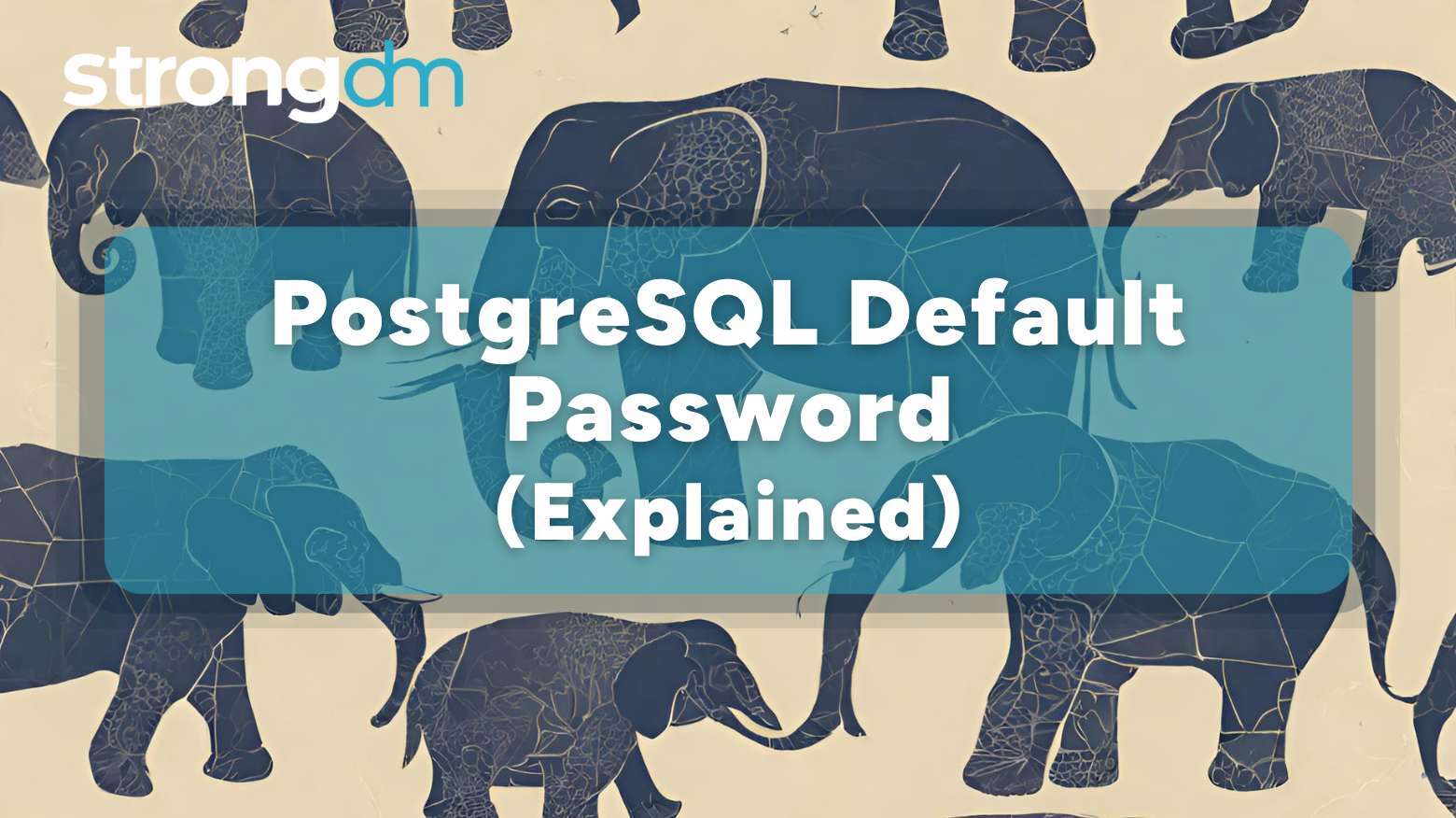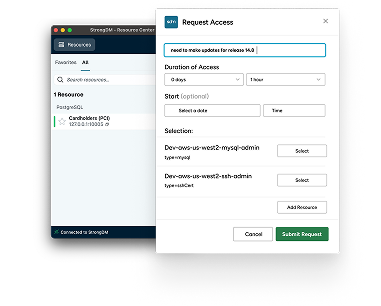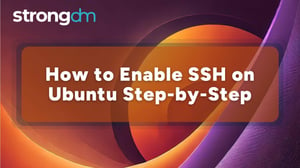

Written by
StrongDM TeamLast updated on:
June 2, 2025Reading time:
Contents
Built for Security. Loved by Devs.
- Free Trial — No Credit Card Needed
- Full Access to All Features
- Trusted by the Fortune 100, early startups, and everyone in between
PostgreSQL doesn’t come with a default password. And while that might seem like a security feature, leaving it unset can be just as risky.
Understanding how Postgres handles authentication—from pg_hba.conf rules to encryption types like MD5 and SCRAM—is essential for keeping your database secure. Missteps in configuration or password management can open the door to unauthorized access.
This guide walks you through initial setup, secure authentication methods, and best practices—plus how to automate PostgreSQL access and password management, so you don’t have to rely on trust-based auth or static credentials ever again.
Is There a Default PostgreSQL Password?
No, there isn’t a default password for PostgreSQL .
When you install PostgreSQL for the first time, it automatically creates a Postgres user without a password. This lack of a password introduces security risks, especially if left that way.
Note: This behavior may vary by installation method and environment. Some distributions and installers (e.g., PostgreSQL on Windows, cloud platforms, and Docker images) may prompt you for a password during setup or configure peer authentication.
How to Set the PostgreSQL Password (First-Time Setup)
After installing PostgreSQL, you can set the password using the psql command-line interface (CLI):
- Connect to the PostgreSQL server as the Postgres user and set the password using this command: "sudo -i -u postgres psql \password postgres"
- From the psql CLI, you can also use this command: ALTER USER postgres WITH PASSWORD "your_secure_password";
Once created, the PostgreSQL database password will now exist in the "pg_authid" system catalog, as hashes or encrypted values (never in plaintext), and is accessible only by superusers for security reasons.
Docker and cloud deployments also require you to create Postgres default passwords during setup. Failing to set it may result in startup errors or security risks.
Default PostgreSQL Authentication Methods
The configuration file , "pg_hba.conf," is what controls client authentication in PostgreSQL. It’s usually located in the database cluster’s directory, but you can place it elsewhere. If you view the "pg_hba.conf" file, you can identify the authentication method for your PostgreSQL server. Authentication rules are processed top to bottom, and the first match is applied.
These methods include:
- Ident authentication: This works by identifying the operating system username and using it as the database’s username. However, the server must be running on a TCP/IP connection. Ident is not available on Windows.
- Peer authentication: Used for local connections only, this authentication method obtains the username for the operating system from the kernel and matches it with the logged-in username for the Postgres database.
- Trust: This method accepts all local connections without a password. It assumes that any user who connects to the database server has access rights.
- MD5 and SCRAM-SHA-256: These password-based authentication methods require a user to send their password, but in hashed formats to prevent sniffing by attackers. Worth noting is that MD5 is older and less secure than SCRAM, which is preferred if supported by the client.
You can set the encryption type you want by editing the "postgresql.conf" file. To do this, find the "password_encryption" parameter and modify it as follows: "password_encryption = 'scram-sha-256.'" Lastly, a PostgreSQL server restart is required for this to take effect.
How to Reset the PostgreSQL Password (If You Forgot It)
As a database administrator, having a lot on your plate means you can get your passwords mixed up. When that happens, you can easily reset the Postgres default password:
- Find the "pg_hba.conf" file. From the data directory, open it and find the lines for local connections (they should start with "local").
- Change the authentication method from MD5 or SCRAM-SHA-256 to "trust."
- Save the file and restart the PostgreSQL server.
- Connect back to PostgreSQL as Postgres and change the password using the psql CLI.
- Change the "pg_hba.conf" file back to MD5 or SCRAM-SHA-256 and restart the service once more.
Note: Changing "pg_hba.conf "to "trust" and restarting PostgreSQL should be done with caution and on an isolated or local system, as it temporarily removes all authentication checks.
Common Pitfalls and Misunderstandings
When dealing with PostgreSQL passwords, there are several mistakes that administrators and developers commonly make. These include:
- You may end up forgetting to create a Postgres user password because you think a default password already exists.
- While editing the "pg_hba.conf" file, you may end up misconfiguring it by, for instance, forgetting to change the authentication method. This may end up welcoming unauthorized access.
PostgreSQL Access and Password Management Best Practices
Understanding common mistakes associated with Postgres passwords gives us insight into best practices we can incorporate, such as:
- Logging and monitoring: You must continuously check who has access to PostgreSQL to ensure hackers don’t infiltrate it. To do this, you can leverage commands that list users and roles, like "\du SELECT rolname, rolcanlogin, rolsuper FROM pg_roles;"
- Using strong passwords and rotating them: The key to creating impenetrable passwords is to adopt best practices for choosing passwords , such as avoiding common phrases, names, and personal information; ensuring your passwords are 12 characters or longer; using random characters; and using secrets management tools or vaults.
- Disabling unused roles: Forgotten or orphaned roles can be the gateway for attackers because they may have weak or compromised passwords. Disabling them means attackers don’t have this opportunity, thus enhancing your security. You can also find potentially risky roles by running "SELECT rolname FROM pg_roles WHERE rolcanlogin AND rolvaliduntil IS NULL;"
- Limiting Postgres superuser use: Superusers have unlimited access and privileges. Therefore, if you use this account with an application that attackers have compromised, they could gain full access to the database.
- Adopting role-based access control (RBAC): This essentially means that the system is set up so that a user has access up to a certain limit, based on their job, and no more than that.
StrongDM’s Approach to Secure PostgreSQL Password and Access Management
PostgreSQL doesn’t ship with a default password—and that’s both a feature and a risk. If you leave the default user (often postgres) unconfigured, your system could be exposed. But configuring it correctly isn’t just about setting a strong password—it’s about managing access, encryption, and oversight at scale.
That’s where StrongDM steps in. While you can secure PostgreSQL manually using pg_hba.conf, psql, and custom auth methods, StrongDM removes the complexity and minimizes risk by automating and centralizing it all.
1. Eliminate Hardcoded and Forgotten Passwords
Manually managing PostgreSQL passwords (or relying on .pgpass files) increases the chance of:
- Leaked credentials in source code
- Forgotten logins or insecure defaults
- Hackers exploiting unused or orphaned roles
StrongDM replaces static passwords with ephemeral credentials tied to identity. No hardcoding. No vault copy-pasting. No weak defaults.
2. Centralize Access and Role Management
PostgreSQL role sprawl happens fast—and that creates security gaps. With StrongDM, you can:
- Enforce least-privilege access with role-based controls
- View all active users and roles in a single dashboard
- Disable unused or stale roles without digging through pg_roles
Whether it’s a developer, data engineer, or CI/CD bot—access is tracked, scoped, and revocable in real time.
3. Enforce Secure Authentication Without Manual Configs
Misconfiguring pg_hba.conf can silently expose your database to unauthorized users. StrongDM ensures:
- No reliance on trust, peer, or misconfigured MD5 rules
- Enforced use of secure authentication (SCRAM-SHA-256 or stronger)
- SSH tunneling or identity-based policies with optional MFA
You don’t need to edit PostgreSQL configs directly—StrongDM enforces policies at the edge.
4. Monitor Access with Full Session Auditing
StrongDM logs every PostgreSQL session, command, and query—automatically. You get:
- Audit trails tied to user identity (not just IP or user-agent)
- Real-time logging to SIEMs like Splunk, Datadog, and Elastic
- Visibility across hybrid or multi-cloud PostgreSQL deployments
No more guessing who connected, when, or what they did.
5. Automate Access and Password Management at Scale
When a new developer joins or a contractor needs temp access, StrongDM:
- Grants access without exposing the actual PostgreSQL password
- Automates provisioning and deprovisioning via identity provider (Okta, Azure AD, etc.)
- Rotates secrets and credentials regularly—without downtime
And if you ever need to reset a password or rotate a secret, it’s done centrally—in seconds.
Manual PostgreSQL password setup is fragile. StrongDM makes access secure, automated, and accountable by default.
Book a demo to see how StrongDM protects your databases without the operational overhead.
Next Steps
StrongDM unifies access management across databases, servers, clusters, and more—for IT, security, and DevOps teams.
- Learn how StrongDM works
- Book a personalized demo
- Start your free StrongDM trial


About the Author
StrongDM Team, Universal Privileged Access Authorization (UPAA), the StrongDM team is building and delivering a Zero Trust Privileged Access Management (PAM), which delivers unparalleled precision in dynamic privileged action control for any type of infrastructure. The frustration-free access stops unsanctioned actions while ensuring continuous compliance.
You May Also Like




